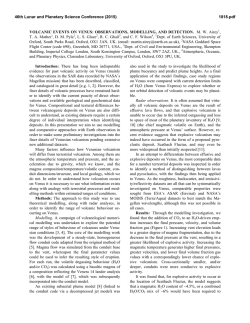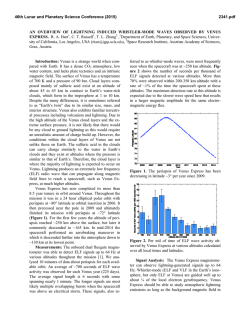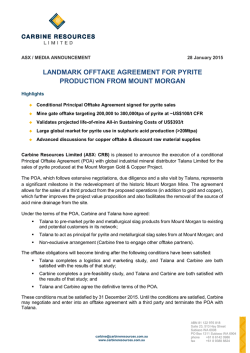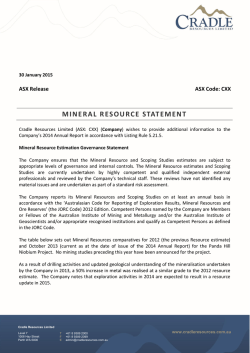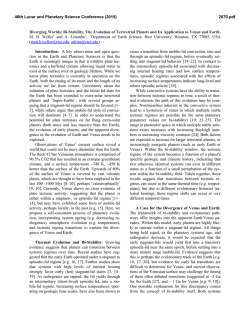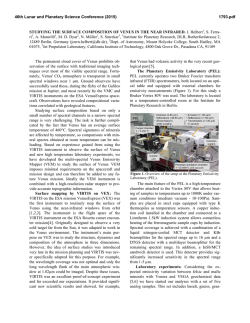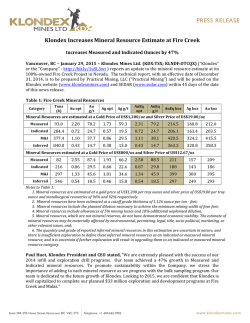
PRELIMINARY ANALYSIS OF PYRITE REACTIVITY UNDER
46th Lunar and Planetary Science Conference (2015) 2027.pdf PRELIMINARY ANALYSIS OF PYRITE REACTIVITY UNDER VENUSIAN TEMPERATURE AND ATMOSPHERE. B. G. Radoman-Shaw1, R. P. Harvey1, N. S. Jacobson2, G. C. C. Costa2 1Department of Earth, Environment, and Planetary Science, Case Western Reserve University, 10900 Euclid Avenue Cleveland, OH 44106 ([email protected]), 2NASA Glenn Research Center, 21000 Brookpark Road Cleveland, OH 44135. Introduction: Measurements of Venus surface chemistry suggest a basaltic composition with a predominantly CO2 atmosphere [1]. In order to understand the reactivity of certain possible mineral species on the surface, previous simulation chambers conduct experiments at 1 atmosphere with a simplified CO2 atmosphere [2]. Following this procedure, pyrite samples are used to estimate the reactivity of sulfide minerals under a Venusian atmosphere and climate. Sulfurous gas species have been identified and quantified in the Venusian atmosphere [1], and sulfurous gas and mineral species are known to be created through volcanism [3], which is suggested to still occur on the surface of Venus [4]. This experimentation is necessary to constrain reactions that could occur between the surface and atmosphere of Venus to understand terrestrial geology in a thick and hot greenhouse atmosphere. Quantifying this reaction can lead to approximations necessary for further experimentation in more complex environments such as those in the GEER chamber at Glenn Research Center that can simulate pressure along with temperature and a more inclusive and representative Venusian atmosphere. Samples: Samples of pyrite were supplied from the Cleveland Museum of Natural History. The three samples prepared for TGA analysis were taken from a single crystal of FeS, characterized mineralogically by XRD and a hole was cut in order to hang them in the TGA apparatus. Each sample is approximately rectangular to provide for a better estimation surface area, which was calculated before and after each reaction. The designation for the samples are R3u 5h, R3u 15h, and R3u 20h. The mass for each of the samples is 0.29284g, 0.38295g, and 0.3364g respectively. The surface area for each of the samples was calculated using ImageJ photoanalysis and the values are 2.195cm2, 1.7876 cm2, and 1.29 cm2. The surface area measurements will illustrate differences in volume that might occur with deposition or etching of the surface as a result of CO2 exposure. Methods: The TGA is an apparatus for measuring mass as a function of time under specific atmospheric flow conditions. For Venus approximately 98% of the atmosphere is CO2 [1]. A platinum rhodium hook of approximately 2 inches was the only material touching the sample and it hung freely during the experiment. The sample and platinum hook was then attached to a quartz rod and a platinum chain inside a quartz tube. This apparatus was balanced with separate metal weights that were also under vacuum during the experiment. The tube was then evacuated twice and the pyrite sample was subjected to a CO2 atmosphere at a rate of 400 cm2/min at 1 atmosphere. Temperature was then raised slowly and incrementally to typical Venus surface temperatures (470°C) to reduce the effects of thermal shock that cracked the previous samples. The mass, temperature, and duration was monitored throughout the experiment and recorded in realtime every 10 seconds during the experiment. The weight on the balance for each of the experiments had a level reading before exposure and any loss of mass is attributed to an oxidizing reaction of the pyrite as a result of the heat and CO2 flow. With the mass monitored versus the time of the respective experiments, the rate of reaction is estimated and any discrepancies seen in rate during the durations can be quantified and analyzed in respect to a possible Venusian style reaction with sulfide. Results: Each of the samples was retrieved from the TGA intact and mass loss is attributed to discrete dust-sized particles being removed as a result of an increase in volume due to the creation of another sulfide mineral. The post exposure samples are darkened when compared to the pre-exposure samples and this discoloration is seen the best in R3u 20h (Figure 2). Also in the post samples there are noticeable cracks and fissures where previously there were smoother surfaces. This is also attributed to the creation of another mineral that has a lesser density. XRD analysis of the surface of the new material shows that it is pyrrhotite, a Fe1-xS mineral. This mineral is a darker color than the pyrite and discolors the specimens. One of the samples, R3u 20h, had a lighter band of material on the A side of that appeared to illustrate some other type of reaction and perhaps another mineral phase (Figure 2). None of the minerals separated into multiple chunks so the structural stress caused by the reaction was not enough to cause fracture along the hole that was drilled. These exposures however are shorter than the ones that are proposed for the GEER chamber at NASA Glenn Research Center. The final masses for each of the specimens in order of increased length of exposure from 5-15-20 hours are 0.29067g, 0.38003, and 0.33166g respectively. Therefore the mass loss is 0.00217g, 0.00292g, and 0.00474g respectively. There is an increase between 5 46th Lunar and Planetary Science Conference (2015) Figure 1: Data points from each of the three runs with rates of reaction excluding the manual increase and decrease of temperature. The masses are different than the sample masses due to the inclusion of the platinum wire, the quartz rod and the platinum chain. And 15 hours but the largest difference is between the 15 and 20-hour samples. The post surface area measurements are 1.694 cm2, 2.4514 cm2, and 1.352 cm2. This means that the surface area difference for the respective samples is -0.501cm2, 0.6638 cm2, and 0.062cm2. There was a loss of surface area for the 5 hours exposure but the two other runs show an increase by varying amounts. The rates of each of the reactions were similar however they were not equal (Figure 1). The largest difference is between the R3u 5h run and the R3u 20h run although they have the most similar mass. The R3u 15h run has the largest mass and its rate is in between the 5 and 20 hour run. In each case the general shape of the sample remains even though the texture and color of the sample is much different. This is most evident in the R3u 5h sample. Discussion: The conversion of pyrite to pyrrhotite and then Fe oxides in a hot CO2 atmosphere (such as found at the surface of Venus) is both known and predicted from prior work; yet the relative importance of this reaction remains controversial [2,5,6]. More recent studies suggest this reaction can play a key role in buffering the abundance and oxidation state of S in that planet's atmosphere, which can differ dramatically with altitude [1,7]. Our experiments illustrate that there are some discrepancies that can occur through length of exposure suggesting mineral textures and volume changes can play key roles. The cracks in the samples, especially in R3u 15h, are most likely due to volume changes associated with newly formed minerals. It is most likely more evident in this sample because it underwent the largest increase in surface area 0.6638cm2. The sample with the decrease in surface area is R3u 20h (Figure 2) and this sample also has the roughest surface area on the backside of the sample whereas R3u 15h and R3u 5h are the smoothest. The 2027.pdf Figure 2: The lighter region after the reaction of R3u 20h. loss of surface area is due to mass loss in minute increments through expansion through the pyrite to pyrrhotite phase change. The heaviest sample is the R3u 15h sample (Figure 1) and this sample fell in between the two extremes of the differences of rate. The difference in rate is similar in magnitude and on average is 0.3 mg/hour. The mass loss increases with length of exposure showing that the pyrite-pyrhottite phase change progresses regardless of the effects of texture and shape. Further Work: The depth and chemical profile of this reaction within the charges will be examine by SEM and FIB. Other volcanic minerals such as olivine, pyroxene and feldspar are also going to be analyzed before exposure in the GEER chamber under the full Venus conditions which could force this reaction to increase or decrease in rate as well as product which might be other than pyrrhotite. The inclusion of SO2 at 180 ppm [1] (detected abundance in the Venusian atmosphere) will offer further insight into these oxidation reactions. References: [1] Bullock M. A. and Grinspoon D. H. (2013) Comparative Climatology of Terrestrial Planets, 19-54. [2] Fegley B. Jr. et al. (1995b) Icarus 108, 373-383. [3] Krasnopolsky V. A. and Lefèvre (2013) Comparative Climatology of Terrestrial Planets, 231-275. [4] Smrekar S. E. et al. (2010) Science 328, 605-608. [5] Hashimoto G.L. and Abe Y. (2005) Planetary and Space Science 53, 839-848. [6] Wood J.A. (1997) Venus II, 637-664. [7] Treiman A. H. and Bullock M. A. (2012) Icarus 217, 534-541.
© Copyright 2026


